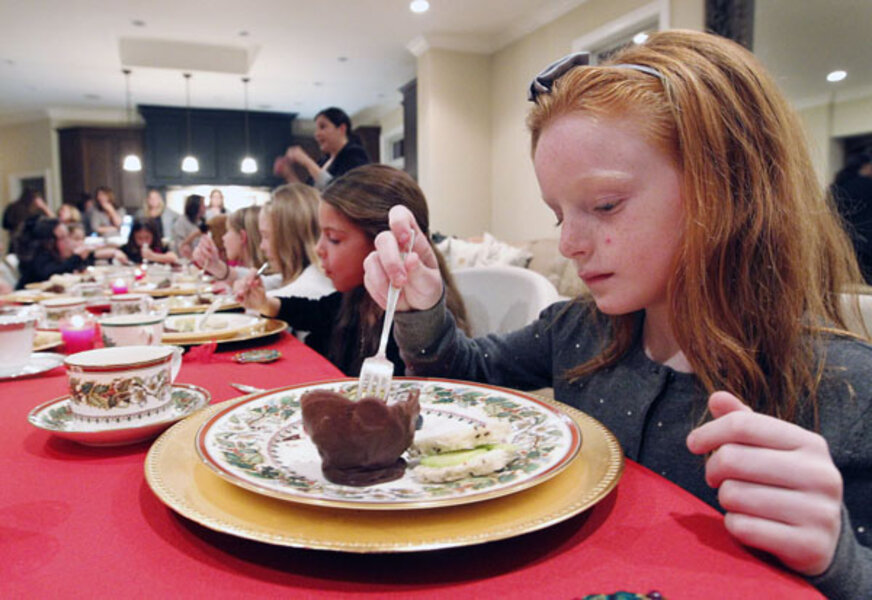Kitchen knives: Teaching culinary conduct to three kids
Loading...
As I set down the orange juice on the breakfast table, I was stopped in my tracks by the sight of my 12-year-old daughter struggling to cut up her pancakes. Holding her knife in her left fist like a ski pole and her fork like a video game controller, she ground the two utensils together until her plate became a mess of shredded, torn pancake bits.
My future Mensa member and current household video game champion had no more ability to use a knife than had our house cat.
How did she escape learning this basic life skill?
Looking back, I admit I purposely kept knives away from my kids. I thought that giving a sharp object to a child could only end badly.
And on the occasion that we went to a restaurant and knives were recklessly set on the table, the inevitable sibling sword fight would ensue, confirming my suspicions.
It’s likely also that kid foods were to blame. After all, one doesn’t need to cut up chicken nuggets, pizza and macaroni and cheese. But most nights my kids dine on more grown-up fare like salmon, shrimp and pastas – again, all fork-friendly foods.
After deciding to brush off the knife incident as a minor blemish on my otherwise spotless parental record, I was faced with another shortcoming.
When we were having some dinner guests, my two older girls wanted me to bake a corn soufflé to serve our dinner guests. Rushed for time, I instructed them to start without me by gathering all the ingredients and opening up the cans of creamed corn.
With the front room finally tidy, I went to check on their progress. I walked in to find every drawer in the kitchen open as my daughters rummaged about, muttering, “I don’t know which one is a can opener. Is this a can opener?”
“No, I think it’s this thing,” the other one said, holding a corkscrew. “Or maybe it’s that thing there?” while pointing at a garlic press.
Astonished, I interrupted. “What? Do you mean to tell me that neither one of you knows what a can opener looks like?”
I reached into the appropriate drawer. “This is a can opener!”
“Oh,” they said in unison.
“You’ve never used a can opener?” I demanded, only to be treated to shrugs and the onset of uncontrollable giggles.
“Oh, yeah. Go ahead and laugh.”
I tried to impress them with the seriousness of the situation. “It won’t be so funny when The Big One comes and Daddy and I are squished under the entertainment center and you kids have to fend for yourselves. What will you do then? Huh? I’ll tell you what you’ll do. You’ll starve! I can see the story on the ten o’clock news now: ‘Local children starve to death in a kitchen surrounded by cans of food!’”
Now gasping for air, Chloe somehow managed to squeak out, “We won’t starve. We’ll just order a pizza.”
I ignored her. “This weekend, the two of you are going to learn about the kitchen, and we will have a special class in advanced knife work.”
Morning came and, after a half-hour of Show and Tell with the kitchen utensils and appliances, I presented my children with a stack of easy-to-cut French Toast.
I gave them a lengthy dissertation on proper knife holding and exact index finger placement for maximum pressure and then encouraged them to try it themselves.
Chloe tried to flaunt her knife skills first, but soon food went flying off the edge of her plate. Samantha made a couple of feeble attempts and then disregarded my advice and began mashing up her French Toast like she had her pancakes. Again, more giggles.
I was ready to admit defeat when my seven-year old asked, “Mommy, am I doing it right?”
To be honest, I forgot my overlooked third child was even at the table. But now, I was thrilled to learn someone had actually been paying attention.
“Why, yes!” I gushed. “You are doing it right! Wow, girls... look at your much younger sister. See how well she wields her knife? Why can’t you two be more like her? Excellent job, Peyton. Here, have some more syrup and powdered sugar.”
I knew very well I had violated the advice of every parenting book by comparing the children to one another, but I didn’t care, I was feeling desperate.
But my efforts were apparently in vain. Chloe and Samantha soon abandoned their utensils entirely and resorted to ripping off bites of French toast with their teeth, much like the feral children they were apparently meant to be.
The good news was that at least my youngest child would someday be able to enter civilized society. In the meantime, I can only hope that video game designers can invent a game that teaches kids how to use a butter knife.
The Christian Science Monitor has assembled a diverse group of the best family and parenting bloggers out there. Our contributing and guest bloggers are not employed or directed by the Monitor, and the views expressed are the bloggers' own, as is responsibility for the content of their blogs.







